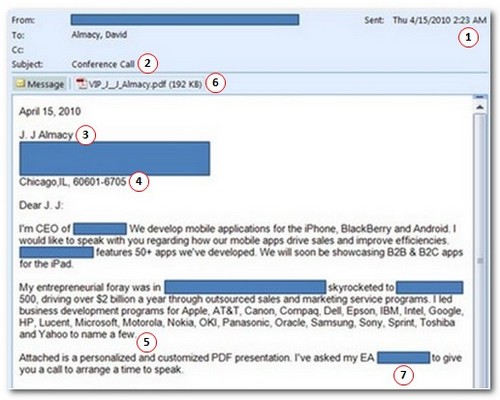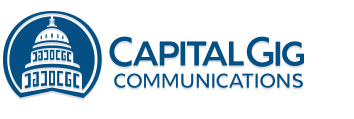Generating new sales leads can be challenging, time consuming and frustrating — but it’s a critical element in growing a business. Believe me, I’ve been there and can sympathize with anyone who has ever had to build a list from scratch, make a cold call or contact someone they simply don’t know.
 Some people really thrive on the excitement of aggressively securing a new lead, while others are uncomfortable with the pursuit. In either case, there’s no excuse — especially with all the information available on the Internet these days — for not performing even the most basic research before reaching out to a prospect.
Some people really thrive on the excitement of aggressively securing a new lead, while others are uncomfortable with the pursuit. In either case, there’s no excuse — especially with all the information available on the Internet these days — for not performing even the most basic research before reaching out to a prospect.
A couple weeks ago, I received an unsolicited sales email. Personally, I prefer to receive a phone call first, but if an email does arrive in my Inbox, I would hope that the sender would at least make sure that it’s relevant to the recipient.
But before I go into more detail about the email itself, I want to share a story from a few years back.
It was 8 PM on a weeknight and I had just arrived home from work a few minutes before. My 2yo daughter was wrapping up dinner. We were just about to head upstairs to get her ready for bed when we were both startled by a knock on the front door. I picked my daughter up in my arms and opened the door.
A young woman, most likely college-aged, stood on the front step with clipboard in hand and a bag full of pamphlets thrown over her shoulder. It was dark out, so I couldn’t immediately determine what was printed on the literature or the reason for her visit.
Without introducing herself, she abruptly started in on her opening pitch and blurted out, “George Bush is ignoring climate change, hates the environment and wants to destroy it. Join us in our fight to stop him!”
Before I could answer, she just kept right on talking. I stood there, staring at her as she spouted off several talking points filled with misinformation, distorted facts and partisan rhetoric. I let her continue for a minute or two, mostly because I wanted to hear what she had to say before I responded.
Unfortunately for her, it wasn’t a fair debate.
I informed her that I was a White House staffer and, just that very day, I had posted several items to WhiteHouse.gov about President Bush’s commitment to the environment including a “Setting the Record Straight” fact sheet entitled, “President Bush’s Strong Record of Addressing Climate Change.” How’s that for good timing?
Many of the statistics were still fresh in my mind and I picked apart her arguments one at a time with facts based on the president’s actual record. However, she was persistent. She kept looking to her clipboard for more talking point ammunition, even repeating a couple that I had just debunked.
All the while, I was holding my 2yo who had been observing our conversation quietly and patiently. My patience, on the other hand, was beginning to wear thin after 15 minutes or so. My 2yo was getting heavy, it was late, we all were tired and I still needed to get her ready for bed.
It was clear that we were just on different sides of the issue and that neither of us would budge so I needed to politely end the discussion. In doing so, I offered a little advice:
“Look, I appreciate and respect the fact that you are going to door-to-door about an issue that you are passionate about. You have every right to do so and I commend you for getting involved and speaking out. However, you’re speaking to a President Bush supporter who is educated on the issues. Plus, you’re in a moderate-to-conservative neighborhood where misrepresenting facts and attacking the president probably won’t go over too well. So, before you start knocking on doors, bothering people late at night in the privacy of their own homes and interrupting family time, I suggest you do the research.”
At that point, my 2yo (who was still learning to talk at the time) pumped her fist in the air and without missing a beat said, “Yeah, do the research!” I couldn’t have chosen a better way to end the conversation myself. We wished her a good night and closed the door.
I’ve told this story a number of times and that phrase, “Do the research!” has become a favorite among family and friends. I think about it now and again, particularly when someone isn’t diligent about obtaining general background information before tackling a project. Plus, it’s just good advice — which brings me to the reason for the post.
As I mentioned, I received an email from a potential vendor that really missed the mark. I have included an image below but have redacted specifically identifiable information to protect the sender’s privacy.

My goal in writing this post is not to publicly embarrass anyone, but rather to point out ways to improve. There’s a right way and a wrong way to write effective email messages and much of it is plain common sense.
Here’s a list of where this email went wrong — along with some friendly “unsolicited” advice:
- Time
Normally, messages sent at 2:23 AM ET wouldn’t be a problem except that my work email account is tied to my BlackBerry which buzzes when a new email arrives. Most of the time I sleep through it, but this one woke me up. Thanks for that.Advice: Be considerate when choosing a day and time to send.
- Subject
I know many rely heavily on catchy subject lines to increase open rates, but “Conference Call” is plain boring and misleading.Advice: Get creative. If not, how about just using the name of the company, products, services or even something simple like “Introduction?”
- Name
My name is David, not J.J. David is in my email address, as well. I have no idea who J.J. is or how I earned that nickname, but this email immediately lost credibility after I read that.Advice: Use a person’s actual name. A formal salutation would be nice, as well.
- Address
I live and work in Washington, DC — not Chicago. Perhaps Chicago is where J.J. lives.Advice: Again, this could have been avoided with a little research. A simple Google search would’ve cleared this up.
- Personalization
In the third paragraph, there’s some language about a “personalized and customized PDF presentation” which is attached to the email. The filename (VIP_J_J_Almacy.pdf) is quasi-personal. Don’t get me wrong, I’m flattered to be considered a “VIP” even if it’s in a PDF filename and I have to go by J.J. to attain that status. However, I was disappointed to see that the PDF was four pages of standard marketing materials with “JJ Almacy” and the name of my employer stamped on every page. There was nothing in there at all that seemed to be directly relevant to my clients or even my line of business.Advice: Slapping someone’s name and company (even the correct one) on a template is not personalization. Even if you can’t cite minute details, providing relevant case studies based on geography or industry specific examples demonstrates a more thoughtful approach.
- Attachment
Since it’s not coming from a trusted source, I am always hesitant to click on attachments for fear that it may be malware or some type of computer virus. Also, larger file sizes may bounce back or could clog up Inboxes.Advice: Avoid attachments in initial email communications. Instead, connect with your potential client first to learn a little about their business objectives & challenges. Then, follow-up with a customized document that offers solutions and demonstrates tangible value for partnership. Another option is to provide links directing people to Web based versions of your case studies on your company Website in the body of your email. Of course, an in-person meeting is typically a more effective and preferred method to walk through presentation materials, if possible.
- Contact
Next, the author — this company’s CEO — indicates that his EA (executive assistant) will be giving me a call to set up a time to speak with him. Really? I understand that some people rely heavily on assistants to manage schedules, but I found the tone of that sentence a little off-putting. If you have the time to send an unsolicited email fraught with errors, you certainly have the time to pick up the phone and call me yourself. Besides, it has been a couple weeks and still no word.Advice: Everyone’s time is valuable. Remember, you are the one who is seeking their attention. So, be polite and respectful in your tone. Lastly, if you say you are going to follow-up, then do it.
If your target database is too large and you can’t do these things in an individualized manner for each person, then you should rethink your strategy.
Bottom line: Know your audience. Treat them with respect. Connect in authentic ways. Personalize without getting too personal. Seek to understand their challenges. Offer solutions. Be sincere.
And, oh yeah, before you begin: Do the research!

Rob
Great advice Dave! Or should I say, JJ “Kid Dyno-mite” Almacy!